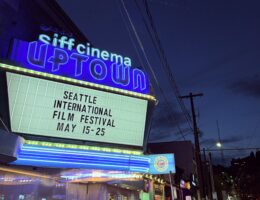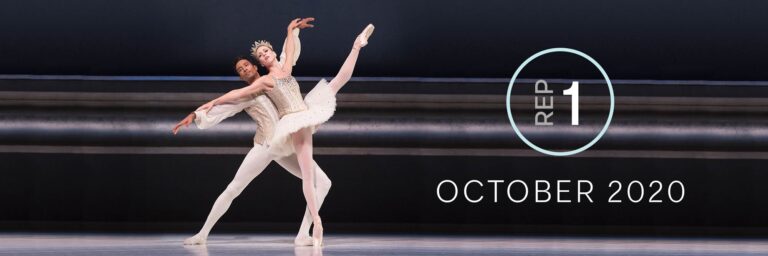PNB is back. PNB is also backs, as dancers facing away from the audience is a real choreographic theme of their first online repertory program.
It’s not a movie, but Pacific Northwest Ballet has made the decision to produce a streaming season–which means that Christmas isn’t cancelled, as this December you can fire up the hot cocoa, lay out the fluffy slippers, and watch The Nutcracker in the comfort of your home. The company has just streamed Rep 1, which is a compelling proof-of-concept for digital delivery. The only downside that I can see is the viewing window felt a little brief: just five days. But Rep 2, featuring a world premiere from Jessica Lang, is coming right up November 12-16.
If nothing is likely to capture the thrill of live performance, there are still real benefits to ballet-by-the-byte, not least of which is the production value that PNB has brought, right out of the gate. You’re unlikely to have ever experienced ballet like this, no matter how good of a seat you managed. The multi-camera work gives you longer shots as if from center house, cut with closer, full-body shots that follow the dancers’ movement across the stage. Unlike real life, you can pause and replay a shockingly fast fouetté. And if you fall in love with a particular piece you can watch it over and over into the small hours of the morning because COVID and who has a schedule these days.
This is all terrific for the audience, but I feel for the dancers. Now they have one performance, not a series, and for those dancers whose performance is fueled by a live audience, rather than a camera, something must feel missing. Yet I was surprised, in Rep 1, how little rust seemed to have collected on the company, given how long the dancers have been off the performance stage. Ballet has always struck me a little like the NBA, in that the athletes don’t really achieve season conditioning until some games in, and spend the rest of the time trying to maintain peak fitness without straying into injury.
It’s true there were some less-than-crisp movements, but there were also performances that dared you to imagine better: I’m thinking of James Moore in Mopey, Angelica Generosa in the Black Swan pas de deux, Christopher D’Ariano in One Body. Mopey is a work from Marco Goecke that combines the third movement of C.P.E. Bach’s Cello Concerto in A minor, Wq. 172, with (Peter Griffin cutaway: YAY!) The Cramps ‘Surfin’ Bird’. It’s a piece that sees Moore, who first appeared in a laced-closed hoodie traversing the front of the stage as if it’s a corridor, bumping along while seated on the floor à la Mr Toad, hand-flapping, trying body-building poses, and commenting on Bach’s musical architecture with boxy juts of his arms. If a first part seems to illustrate a soul unable to find a place to perch, a soundless interlude brings up movements that gain purpose and coherence as ‘Surfin’ Bird’ plays, the sporadic hand-flaps turning to air-plucking wing-fingers. One of Moore’s many gifts as a dancer is the ability to move–I swear this is true–between temporal dimensions, so that he can appear suddenly to be filmed in Matrix bullet-time. I’ve never seen anything like it.
Generosa was dancing Odile from Stowell’s Swan Lake, and it was the kind of performance that makes you think that maybe you’ve had Odile all wrong, my goodness this person isn’t an evil temptress–she’s got a commanding presence, certainly, self-confidence in spades, and who wouldn’t want to be in the company of so quick–well, now you’re feeling a little dizzy how many turns was that. Generosa uses her frame to build steely little arches in space, one moment leaning in, then–oops, jk, bro–snapping back. Her Black Swan is a bit of un oiseau rebelle, to mix arts media. Countertenor Bruce Rameker sings “the flowing spiral” lyrics in John Kennedy’s “Prayer for the Great Family” (on the Gary Snyder poem, for you old-timer hippies) just as Christopher D’Ariano turns and spins in space, and that synchronicity that choreographer Albert Evans built into One Body felt like such a happy event. The excerpt is meditative, and D’Ariano let it unspool with an economy of movement that felt as quietly timeless as, sure, a scene on a Grecian urn. Read your Keats, people.
You’ll notice from that list a peculiarity of our pandemical times, which is that the program was mainly solos, pas de deux, or other small groups, which allowed rehearsal to take place without putting larger numbers of dancers at risk. Certain pieces play well in this context: Balanchine’s ‘Emeralds’, ‘Rubies’, and ‘Diamonds’ are largely about a spotlight shining on solo dancers or couples (Sarah-Gabrielle Ryan displaying exactly the kind of temperament that makes these pieces sparkle, so much so that partner Kyle Davis seemed a little daunted at times; when Lesley Rausch and Jerome Tisserand appeared, it was like glimpsing royalty, that long-practiced ease with the precise details of the House of Balanchine). On the other hand, the excerpts from Ulysses Dove’s Red Angels and Eva Stone’s F O I L made me itch to see the whole pieces again.
I know this review shorts Dylan Wald’s outstretched yearning in Lang’s The Calling, a dance notable for its rootedness in place, the dancer appearing in a pool of skirt that stretches out some yards, and Elle Macy and Wald as an engaging couple in The Trees The Trees, choreographed by Robyn Mineko Williams, but I’m told people on the internet don’t read past the second paragraph, and look where we are. I feel especially bad then for saving mention of Lucien Postlewaite’s Man in Brown from Robbin’s Dances at a Gathering for last. Postlewaite danced it with a preoccupied self-awareness, as if musing over past steps, and with a risky looseness (for ballet) that gave dimension to the role, a literal gravitas, as one battement just barely completed before he returning to earth. This was like, I don’t know, a 40-ish Sinatra who’s been up and down and over and out: flippant, a little bruised, but still leaning into it, just watch him sail on that last jump.



